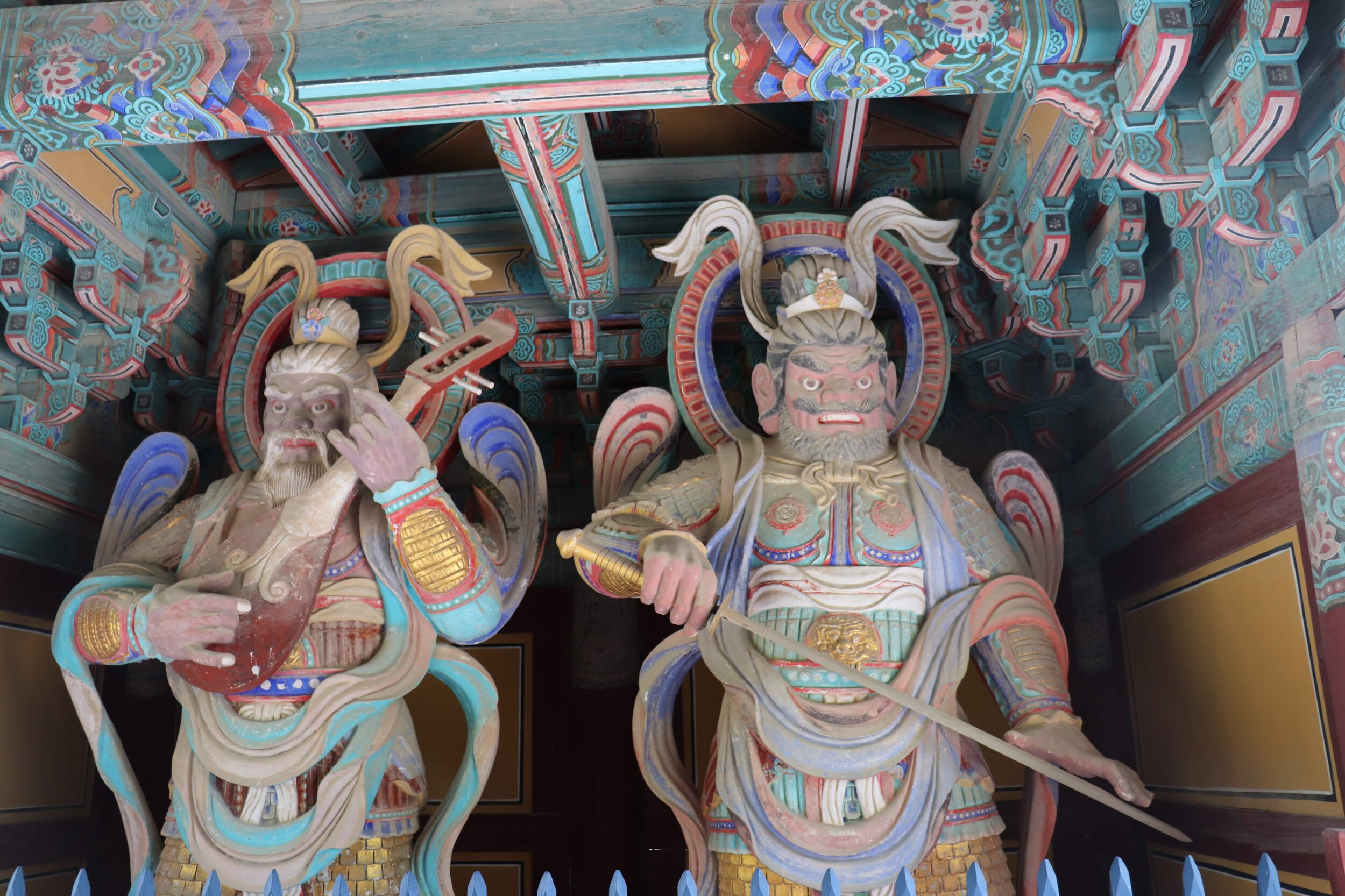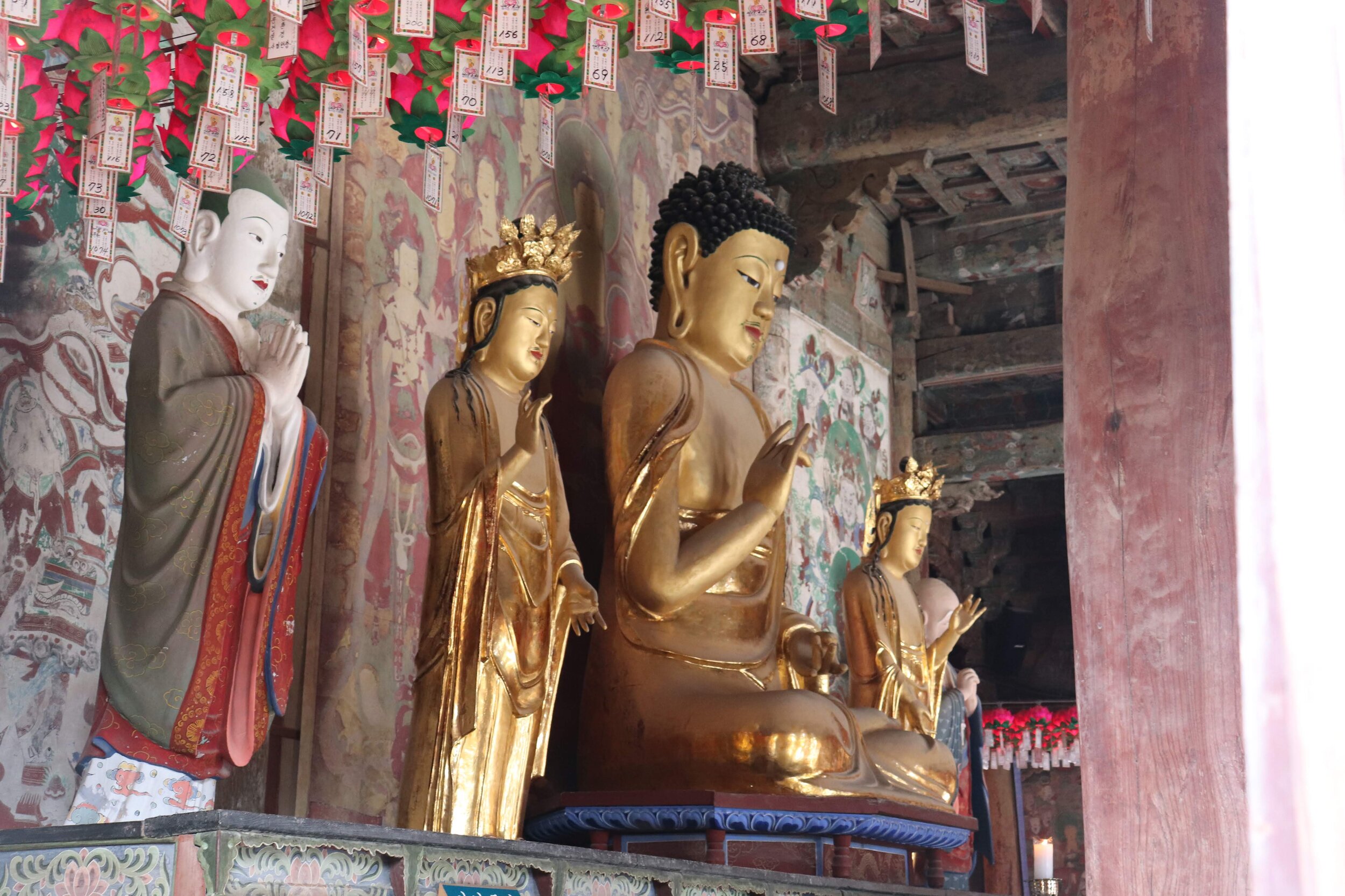Busan 2019, Day 2
For our first full day in Busan, we booked a tour guide to take us to the city of Gyeongju, which was the capital of the ancient Silla kingdom. At this point, the typhoon had mostly passed us, so we were lucky that it wasn’t raining. Before I continue, I’ll have to admit that I remember very little about this part of our trip. Like, I’ve pretty much forgotten the historical significance of the places we went to, so I’m probably not going to have much to say, but at least I’ll share some photos.
Our first stop was Bulguksa Temple, which is a large Buddhist temple located in the mountains. I think portions of the temple were destroyed or damaged during the Korean war, because various sources state that there was extensive reconstruction work after the war ended. In any case, the many structures that are still on the grounds were painted in vibrant blues, golds, and reds:
The buddha statues there were also beautifully painted:
We continued to wander the grounds for a while, and then drove off to our next stop, the Seokguram Grotto. On the way there, I believe our tour guide mentioned something about how Japan went around destroying various Buddhist temples and statues in the area. I’m not sure how much of that is true, but he did harbor some ill feelings towards the Japanese for their actions during the war. I don’t think we mentioned that after Busan, we were going to go to Japan, so we just nodded our heads and continued walking along the trail to the grotto. On the way there, we saw a cute chipmunk enjoying its lunch:
After a short walk from the parking lot, we made it to the grotto:
It’s actually located quite a ways up the mountain, so looking away from the grotto, you get a nice view of the valley below:
Inside the grotto is a large Buddha statue, but they didn’t allow any photos inside, so we have none to show you. However, given that it’s completely enclosed, the size of the statue was very impressive. We also saw a short video of how the statue was built and how the grotto walls were then placed around the statue to create the space that exists now. There was a lot of effort put into building the grotto, which is probably why it’s one of the national treasures of Korea.
Our next stop was the Daereungwon Tomb Complex, which houses many tombs of ancient royalty, including the tomb of a king. Each tomb is buried under a large mound, so when you walk through the area, you’re surrounded by many artificial looking hills:
Our guide explained to us that the larger the hill, the wealthier the deceased was, so I guess size mattered back then. He also told us that back when he was a kid in the late 80s, he would climb the mounds because it was still a park back then, but now that’s strictly prohibited.
The tomb containing the king, whom they have yet to identify, is open to the public. Of course, it’s one of the largest mounds in the area, so walking inside didn’t feel too claustrophobic, which was good news for Nick. We continued to walk the grounds of the complex, and at one point, we saw a bunch of people lining up for a specific photo op:
I decided that it wasn’t worth waiting in line, so I had Nick take this photo instead:
Next to the tombs was a cute little village, so we wandered around for a bit:
We headed back to Busan, and on our way to the hotel, our tour guide asked us what we were planning on doing for dinner. We had no actual plans, so he suggested finding a place that serves Dwaeji Gukbap, which is a pork soup that is local to Busan. We were fascinated by this, and after some quick Google searches, we soon discovered that our hotel was located next to a small street that had many restaurants serving this local dish. But before we had dinner, Nick wanted a drink, so we found this cute little bar on wheels:
And then we headed to the street with many Dwaeji Gukbap restaurants, and saw this:
Apparently, they cook the broth outside on the street. Remind us never to bring any vegetarians or vegans here…
Inside, Nick was the only white person, and no one there really spoke much English, so it felt quite authentic. They had an English menu, so ordering wasn’t too bad because we could point to what we wanted. We ordered what appeared to be the basic Dwaeji Gukbap dish on the menu for the both of us, and a few minutes later, all of these dishes were placed on our table:
At one point, we were like, what do we do with this raw garlic, and then one of the women came to our table. She didn’t speak any English, but with some pointing and gestures, we gathered that we were supposed to take the garlic, dip it in one of the bean sauces, and then eat it. It seemed strange, but we tried it and it was amazing! The entire dinner was delicious, and we were so happy that our guide suggested that we try this, especially because we can’t find this anywhere in the Seattle area.
We ended our night by walking around the city, and finding our new favorite dessert chain, Sulbing. They specialize in Korean shaved ice, and have many different flavors to choose from. We went with the seasonal strawberry sulbing, and it was wonderful:
This location was on the second floor, and we chose a table next to the window, so we had a great view of the street below while enjoying our dessert.
We then headed back to the hotel to sleep and prepare for our last day in Busan





























